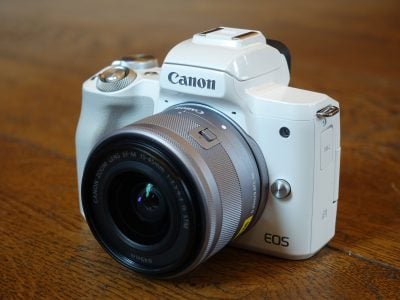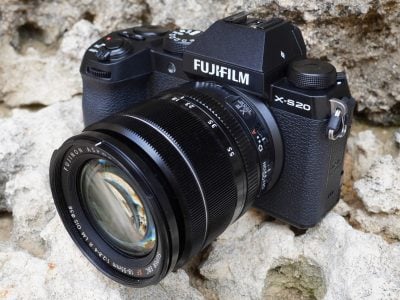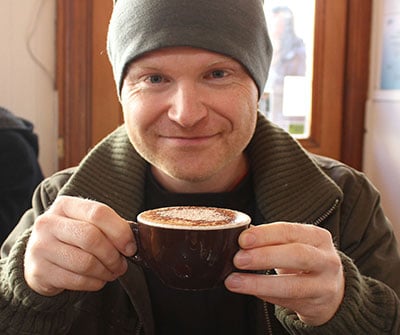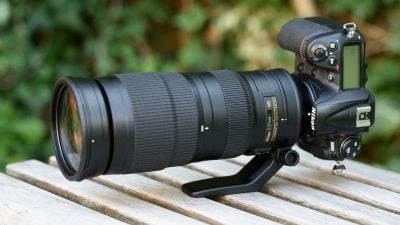Nikon 200-500mm f5.6E VR review
-
-
Written by Thomas
Quality
Sharpness and contrast
Let’s have a look at the theoretical performance of the new lens (first pair of MTF-charts) at the wide and the long end first and compare it to the performance of the Sigma 150-600 Sports (second pair of MTF-charts):
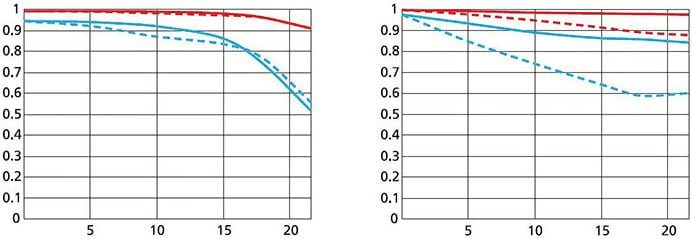
Above: Nikon AF-S 200-500/5.6E VR MTF; left at 200mm, f5.6; right at 500mm, f5.6
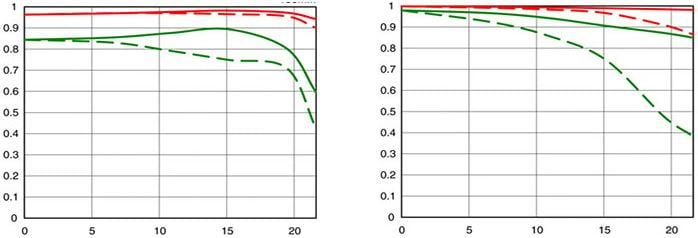
Above: Sigma 150-600/5.0-6.3 DG OS HSM Sports MTF; left at 150mm, f5.0; right at 600mm, f6.3
These charts show the lens-performance at the largest aperture. Higher values are better and the closer the dotted and the continuous lines of each color are together the less astigmatism (= resolution depends on the orientation of the test-pattern) the lens has. The x-axis displays the distance from the optical axis (=center of the sensor) in mm. I’ll show you the real-life performance at 4 mm (center), 13 mm (DX-corner), and 20 mm (FX-corner) on a D810.
From the charts, the new Nikon should be the better performer as its lines always stay above the respective curves from the Sigma. But let’s see how this theoretical performance translates into real life results in the sharpness test based on Siemens-stars.
What follows are near-center results (first column) followed by DX-corner results and FX-corner results on a D810. The D810 results from the DX-corner should be a very good approximation for performance on a 16MP DX sensor (like the D7000), because the pixel-pitch of both sensors are the same. But differences in the AA-filter and micro-lens-design of a D810 and a D7000 might yield different end-results.
Processing was done in Lightroom 5.7.1 from RAW at Camera Standard settings. Noise-reduction is set to 0, sharpening to 35/0.5/36/10, with no extra tone, color, or saturation-adjustment. White-balance was adjusted to a neutral white and I did some exposure compensation to make the brightness match. CA-removal is ON.
The following are all 100% crops!
Let’s have a look at the performance at 200mm focal length first:
Nikon AF-S 200-500/5.6E VR shot with Nikon D810; 100% crop from center, DX-corner, FX-corner

Above: 200mm, f5.6

Above: 200mm, f8.0

Above: 200mm, f11

Above: 200mm, f16
Following is a comparison with other super-telephoto zooms at 210mm, f5.6:

Above: Nikon AF-S 200-500/5.6E VR at 200mm, f5.6

Above: Sigma 150-600/5.0-6.3 OS “Contemporary” at 210mm, f5.6

Above: Sigma 150-600/5.0-6.3 OS “Sports” at 210mm, f5.6

Above: Tamron 150-600/5.0-6.3 VC (A011) at 210mm, f5.6
Performance at 300mm:
Nikon AF-S 200-500/5.6E VR shot with Nikon D810; 100% crop from center, DX-corner, FX-corner

Above: 300mm, f5.6

Above: 300mm, f8.0

Above: 300mm, f11

Above: 300mm, f16
Following is a comparison with other super-telephoto zooms at 300mm, f5.6:

Above: Nikon AF-S 200-500/5.6E VR at 300mm, f5.6

Above: Sigma 150-600/5.0-6.3 OS “Contemporary” at 300mm, f5.6

Above: Sigma 150-600/5.0-6.3 OS “Sports” at 300mm, f5.6

Above: Tamron 150-600/5.0-6.3 VC (A011) at 300mm, f5.6
These 100% crops directly from a 36MP D810 sensor show that the Nikon lens delivers an impeccable performance at 200mm and 300mm right from the start. It delivers a very high contrast and resolves fine details extraordinarily well even wide open and right into the corners of the FX-sensor. Diffraction is setting in at f11 and distortions are minimal. All crops in a row were taken from the same shot, so there’s no field-curvature to talk about.
But the competition is not far behind: The Tamron has the clearest FX-corner of the bunch at 200mm and the Sigma “S” is the best across the frame at 300mm. But both are not quite as good as the Nikon. The Sigma “C” showed a little field curvature at 200mm and 300mm.
Performance at 400mm:
Nikon AF-S 200-500/5.6E VR shot with Nikon D810; 100% crop from center, DX-corner, FX-corner

Above: 400mm, f5.6

Above: 400mm, f8.0

Above: 400mm, f11

Above: 400mm, f16
Following is a comparison with other super-telephoto zooms at 400mm, f6.0:

Above: Nikon AF-S 200-500/5.6E VR at 400mm, f5.6

Above: Sigma 150-600/5.0-6.3 OS “Contemporary” at 400mm, f6.0

Above: Sigma 150-600/5.0-6.3 OS “Sports” at 400mm, f6.0

Above: Tamron 150-600/5.0-6.3 VC (A011) at 400mm, f6.0
With the Nikon there’s a slight softening of the FX-corner at 400mm and some field-curvature is beginning to show: I had to focus a little differently for optimal results in the FX-corner. The competition also shows some degradation of image quality even in the center. Both the Sigma “S” and the Tamron produce FX-corners that are comparable to the Nikon.
Performance at 500mm:
Nikon AF-S 200-500/5.6E VR shot with Nikon D810; 100% crop from center, DX-corner, FX-corner

Above: 500mm, f5.6

Above: 500mm, f8.0

Above: 500mm, f11

Above: 500mm, f16
Compared to other lenses at 500mm, f5.6-6.3:

Above: Nikon AF-S 200-500/5.6E VR at 500mm, f5.6

Above: Sigma 150-600/5.0-6.3 OS “Contemporary” at 500mm, f6.0

Above: Sigma 150-600/5.0-6.3 OS “Sports” at 500mm, f6.3

Above: Tamron 150-600/5.0-6.3 VC (A011) at 500mm, f6.3
At 500mm the Nikon shows some light bleeding into the black areas from residual spherical aberrations and the overall contrast wide open is a bit reduced. This leads to a haziness in the FX-corner but still fine details shine through. With the competition the performance is a bit mixed: The Sigma “C” performs best in the center, the Tamron has the best DX-corner and the Sigma “S” has the clearest FX-corner.
Performance with teleconverter Nikon AF-S TC-14E III
As the new Nikon super-telephoto zoom is such a fine performer, let’s see what it can deliver with a 1.4x teleconverter, which converts the lens into a 280-700mm f8.0E VR that can still autofocus on the following Nikon DSLRs: D4, D4S, Df, D600, D610, D750, D800, D800E, D810, D7100, D7200.
Performance with 1.4x tele-converter TC-14E III at 600mm:
Nikon AF-S 200-500/5.6E VR + TC-14E III shot with Nikon D810
100% crop from center, DX-corner, FX-corner

Above: 600mm, f8.0

Above: 600mm, f11

Above: 600mm, f16
Compared to other lenses at 600mm, f8.0:

Above: Nikon AF-S 200-500/5.6E VR + TC-14E III at 600mm, f8.0

Above: Sigma 150-600/5.0-6.3 OS “Contemporary” at 600mm, f8.0

Above: Sigma 150-600/5.0-6.3 OS “Sports” at 600mm, f8.0

Above: Tamron 150-600/5.0-6.3 VC (A011) at 600mm, f8.0
It’s quite astonishing what the Nikon delivers in combination with a 1.4x teleconverter: There is some loss of overall contrast wide open, but fine details are still reproduced convincingly and as good as from the competition. Stop down to f11 and you get a very good performance. I also tested the Nikon with teleconverter at 400mm focal length (not shown here) and sharpness and contrast was very close to its native performance at 400mm without teleconverter. So you can confidently shoot this lens with a teleconverter even at the shorter focal lengths should you not have the time to swap out the teleconverter while shooting.
Performance with 1.4x tele-converter TC-14E III at 700mm:
Nikon AF-S 200-500/5.6E VR + TC-14E III shot with Nikon D810
100% crop from center, DX-corner, FX-corner

Above: 700mm, f8.0

Above: 700mm, f11
Now at 700mm the new Nikon looks its worst, but that was to be expected. Wide open overall contrast even in the center is relatively low but the amount of detail is not too bad. Pull up clarity and use a radius of 1.0 for sharpening (instead of the 0.5 radius applied here) and you can recover quite a bit of detail. Or you stop down to f11.
Performance at long distances
The Siemens-star test-targets are shot at a distance of 40x focal length (i.e. at 20 m for 500 mm focal length). But performance of lenses also depends on the shooting distance. Therefore I present another series of test-shots of a landscape dubbed the “Unremarkables” where you can measure distances in km, not meter. Processing was done in Lightroom 5.7.1 from RAW at Adobe Standard settings. Noise-reduction is set to 0, sharpening to 35/0.5/36/10, with no extra tone, or saturation-adjustment. There’s no tinkering with vignette-control so you see it here as it is produced by the lens. Focus was acquired at the largest aperture manually and not changed for other apertures.
You can click on each image or crop to access the large original. Please respect our copyright and only use those images for personal use.
The main image shows the complete scene at f5.6 to give you an impression of the angle of view and to judge vignetting. You can access the respective shots at f8.0, f11 and f16 via the links beneath each image. All shots were made at ISO 64 and VR switched off. Following the main image are 100% crops from the center, the DX-corner and the FX-corner from the Nikon followed by comparable crops from the Sigma 150-600mm Contemporary, the Sigma 150-600mm Sports, and the Tamron 150-600mm.
One word of warning though before I present the main results of over 150 test-shots made over a period of 90 minutes: Shooting over distances of 3km with such long lenses is a very risky business even from a heavy duty tripod whose head alone weighs over 2kg. Extending the lenses to their longest focal length and using the lens-hood gives every gust of wind a long lever to shake the whole setup in a way that you can easily see in magnified live view. I switched to 200 ISO to stay on the safe side with short shutter speeds. But stop down to f11 and you’re around 1/500 sec which is already in the danger-zone. Then there is the optical quality of the air between the camera and the target: When the sun warms the ground thermals (bubbles of warm air) can develop which have a different refractive index than the surrounding cooler air and can act like a lens. And with a real-life shot like this I cannot refocus for different areas to compensate for field-curvature nor can I pick the best corner of a not-well-centered lens for a comparison. To make a long story short: I tried to bring you valid shots of all four lenses in this comparison, but take the results with the caveats above.
Let’s start with 200mm focal length:
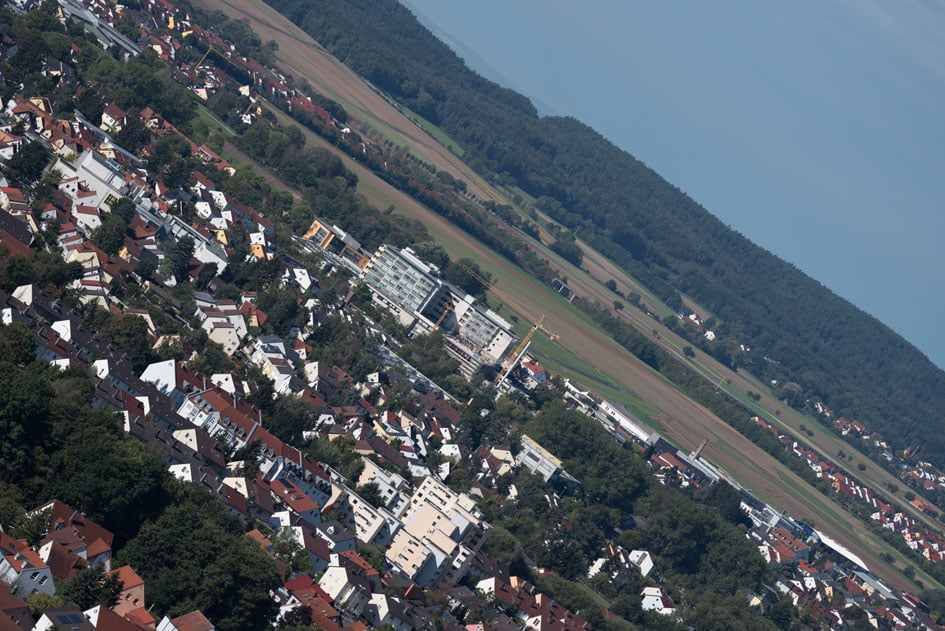
Above: Nikon 200-500/5.6E VR at 200mm, f5.6, 200 ISO; also available at f8.0, f11, f16
Compared to other lenses at 200mm, f5.6:

Above: Nikon 200-500/5.6E VR at 200mm, f5.6, 200 ISO

Above: Sigma 150-600/5.0-6.3 OS “Contemporary” at 200mm, f5.6, 200 ISO

Above: Sigma 150-600/5.0-6.3 OS “Sports” at 200mm, f5.6, 200 ISO

Above: Tamron 150-600/5.0-6.3 VC (A011) at 200mm, f5.6, 200 ISO
Compared to other lenses at 200mm, f8.0:

Above: Nikon 200-500/5.6E VR at 200mm, f8.0, 200 ISO

Above: Sigma 150-600/5.0-6.3 OS “Contemporary” at 200mm, f8.0, 200 ISO

Above: Sigma 150-600/5.0-6.3 OS “Sports” at 200mm, f8.0, 200 ISO

Above: Tamron 150-600/5.0-6.3 VC (A011) at 200mm, f8.0, 200 ISO
At 200mm the Nikon clearly is the winner at f5.6 and f8.0. Its reproduction of the scene is very sharp up into the FX-corner.
Results at 300mm:
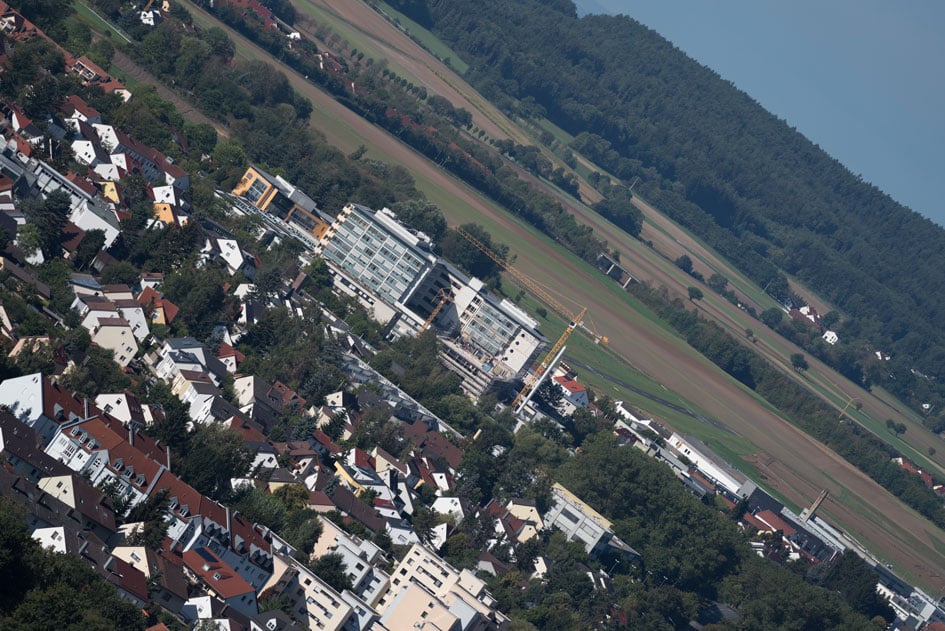
Above: Nikon 200-500/5.6E VR at 300mm, f5.6, 200 ISO; also available at f8.0, f11, f16
Compared to other lenses at 300mm, f5.6:

Above: Nikon 200-500/5.6E VR at 300mm, f5.6, 200 ISO

Above: Sigma 150-600/5.0-6.3 OS “Contemporary” at 300mm, f5.6, 200 ISO

Above: Sigma 150-600/5.0-6.3 OS “Sports” at 300mm, f5.6, 200 ISO

Above: Tamron 150-600/5.0-6.3 VC (A011) at 300mm, f5.6, 200 ISO
Compared to other lenses at 300mm, f8.0:

Above: Nikon 200-500/5.6E VR at 300mm, f8.0, 200 ISO

Above: Sigma 150-600/5.0-6.3 OS “Contemporary” at 300mm, f8.0, 200 ISO

Above: Sigma 150-600/5.0-6.3 OS “Sports” at 300mm, f8.0, 200 ISO

Above: Tamron 150-600/5.0-6.3 VC (A011) at 300mm, f8.0, 200 ISO
At 300mm the FX-corner of the Nikon softens a bit and the Tamron comes pretty close in performance.
Results at 400mm:
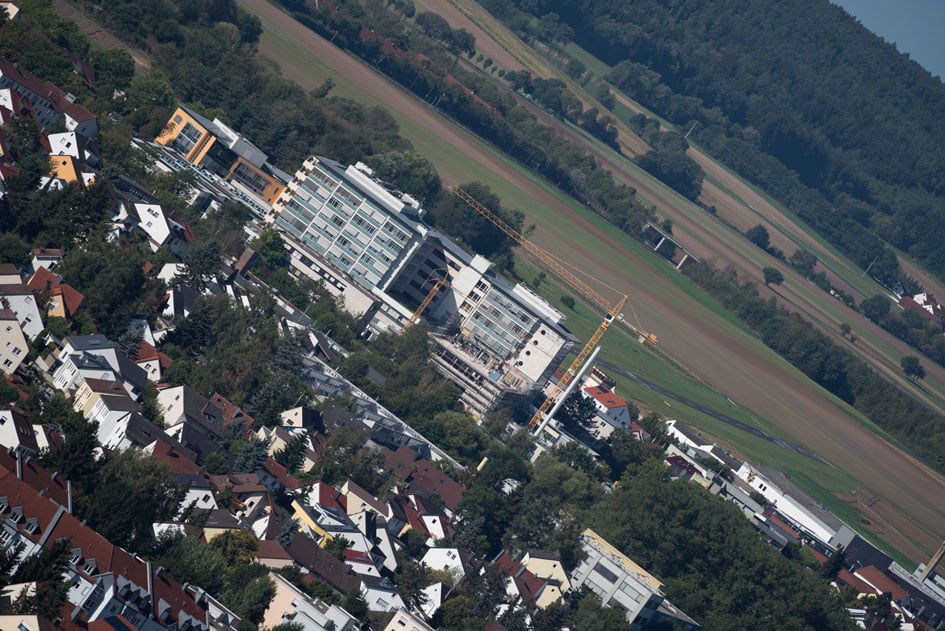
Above: Nikon 200-500/5.6E VR at 200mm, f5.6, 200 ISO; also available at f8.0, f11, f16
Compared to other lenses at 400mm, f5.6-f6.0:

Above: Nikon 200-500/5.6E VR at 400mm, f5.6, 200 ISO

Above: Sigma 150-600/5.0-6.3 OS “Contemporary” at 400mm, f6.0, 200 ISO

Above: Sigma 150-600/5.0-6.3 OS “Sports” at 400mm, f6.0, 200 ISO

Above: Tamron 150-600/5.0-6.3 VC (A011) at 400mm, f6.0, 200 ISO
Compared to other lenses at 400mm, f8.0:

Above: Nikon 200-500/5.6E VR at 400mm, f8.0, 200 ISO

Above: Sigma 150-600/5.0-6.3 OS “Contemporary” at 400mm, f8.0, 200 ISO

Above: Sigma 150-600/5.0-6.3 OS “Sports” at 400mm, f8.0, 200 ISO

Above: Tamron 150-600/5.0-6.3 VC (A011) at 400mm, f8.0, 200 ISO
At 400mm again the Nikon is the clear winner with very good details across the sensor even at f5.6.
Results at 500mm:
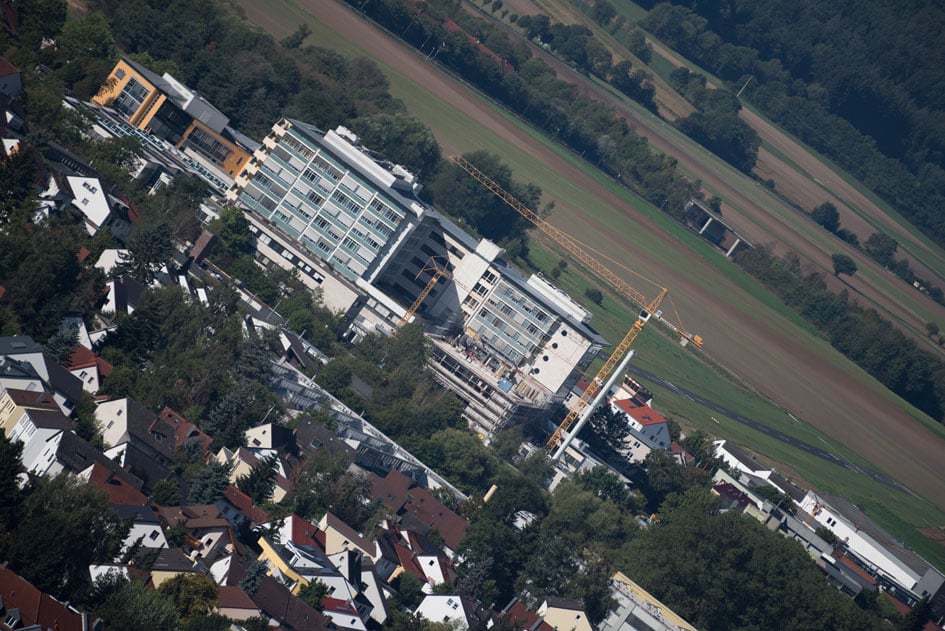
Above: Nikon 200-500/5.6E VR at 500mm, f5.6, 200 ISO; also available at f8.0, f11, f16
Compared to other lenses at 500mm, f5.6-f6.3:

Above: Nikon 200-500/5.6E VR at 500mm, f5.6, 200 ISO

Above: Sigma 150-600/5.0-6.3 OS “Contemporary” at 500mm, f6.0, 200 ISO

Above: Sigma 150-600/5.0-6.3 OS “Sports” at 500mm, f6.3, 200 ISO

Above: Tamron 150-600/5.0-6.3 VC (A011) at 500mm, f6.3, 200 ISO
Compared to other lenses at 500mm, f8.0:

Above: Nikon 200-500/5.6E VR at 500mm, f8.0, 200 ISO

Above: Sigma 150-600/5.0-6.3 OS “Contemporary” at 500mm, f8.0, 200 ISO

Above: Sigma 150-600/5.0-6.3 OS “Sports” at 500mm, f8.0, 200 ISO

Above: Tamron 150-600/5.0-6.3 VC (A011) at 500mm, f8.0, 200 ISO
At 500mm the Tamron drops to last place in this competition with the Sigmas in 2nd and 3rd place. 1st place again for the Nikon.
Performance at long distances with 1.4x teleconverter
I shot the same scene from the same vantage point using the Nikon TC-14E III teleconverter at 500mm, 600mm and 700mm focal length. See how it compares at 500mm first:

Above: Nikon 200-500/5.6E VR + TC-14E III at 500mm, f8.0, 200 ISO; also available at f11, f16
Compared to other lenses at 500mm, f8:

Above: Nikon 200-500/5.6E VR + TC-14E III at 500mm, f8.0, 200 ISO

Above: Nikon 200-500/5.6E VR at 500mm, f8.0, 200 ISO

Above: Sigma 150-600/5.0-6.3 OS “Contemporary” at 500mm, f8.0, 200 ISO

Above: Sigma 150-600/5.0-6.3 OS “Sports” at 500mm, f8.0, 200 ISO

Above: Tamron 150-600/5.0-6.3 VC (A011) at 500mm, f8.0, 200 ISO
Interestingly the center results of the Nikon look better with teleconverter than without. And the differences at the DX-corner or the FX-corner or only minimal. That is quite a feat!
Performance and comparison at 600mm:
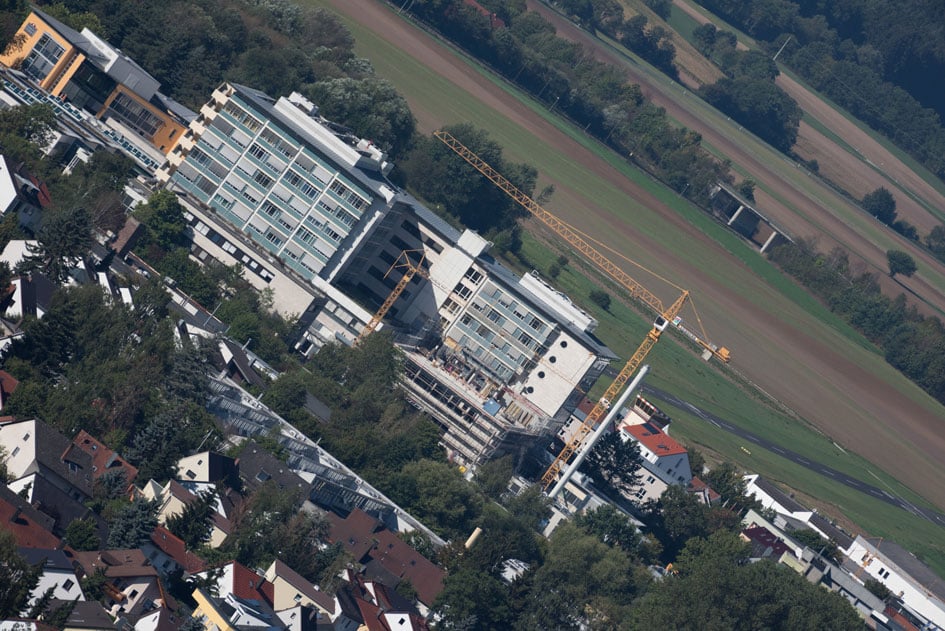
Above: Nikon 200-500/5.6E VR + TC-14E III at 600mm, f8.0, 200 ISO; also available at f11, f16
Compared to other lenses at 600mm, f8:

Above: Nikon 200-500/5.6E VR + TC-14E III at 600mm, f8.0, 200 ISO

Above: Sigma 150-600/5.0-6.3 OS “Contemporary” at 600mm, f8.0, 200 ISO

Above: Sigma 150-600/5.0-6.3 OS “Sports” at 600mm, f8.0, 200 ISO

Above: Tamron 150-600/5.0-6.3 VC (A011) at 600mm, f8.0, 200 ISO
At 600mm the Nikon combo again delivers the best performance with the Sigma “C” pretty close.
Performance at 700mm:
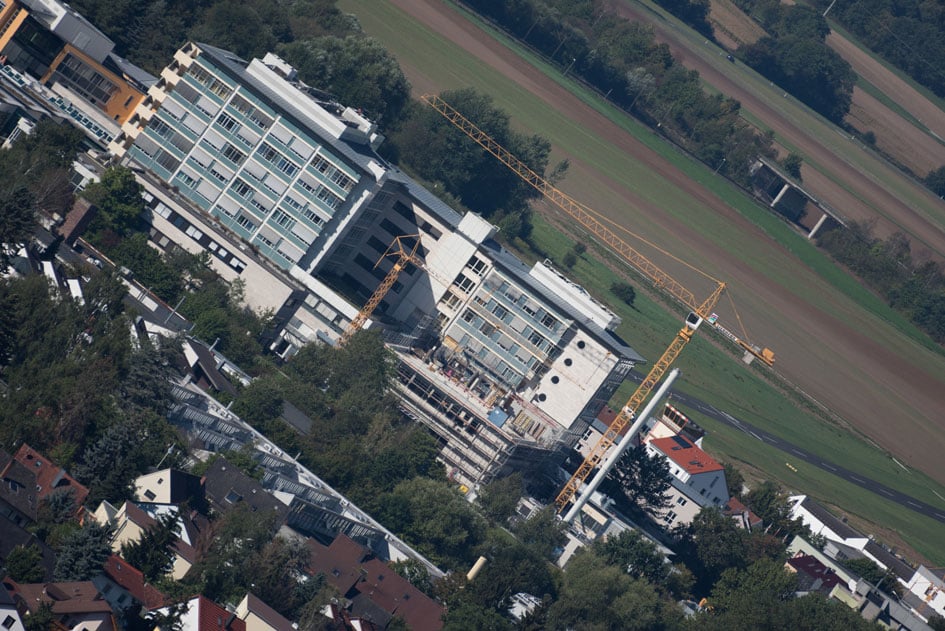
Above: Nikon 200-500/5.6E VR + TC-14E III at 700mm, f8.0, 200 ISO; also available at f16

Above: Nikon 200-500/5.6E VR + TC-14E III at 700mm, f8.0, 200 ISO
At 700mm and wide open there does not seem to be any more detail than at 600mm. Unfortunately I could not use my test-shot at f11 as it does not display optimum sharpness probably caused by shake.
All-in-all the lens is a very impressive performer near and far. It delivers sharper and more contrasty images than the competition in almost every comparison. And it shows quite a surprising performance in combination with the Nikon TC-14E III as every teleconverter magnifies the flaws of a lens.
Rendering of out-of-focus point-light sources
This test is for the rendering of point-light sources in an out-of-focus background. The circle of confusion that is produced by this test is pretty indicative of Bokeh performance (in the background) and light fall-off. Ideally the out-of-focus image of the point-light is evenly lit and perfectly circular, with no “onion-rings”, and without coloration. Large aperture lenses normally produce an effect known as “cat’s eye” the further away from the optical axis the point-light is projected. This is due to optical vignetting in the lens barrel when light enters the lens from an angle. For an explanation of this effect have a look over at toothwalker.org.

Above: Nikon 200-500/5.6E VR at 500mm, f5.6; also available at f8.0, f11, f16
The Nikon 200-500/5.6E VR produces a large circle of confusion. It exhibits a very even light-distribution across the circle but with a little outline. The outlining is of the same color as the main body of the Bokeh ball which is an indicator of very low longitudinal CA of this lens. The lens shows some obvious cat’s-eye effect towards the borders/corners of the sensor but there is no clipping from the mirror-box.
Flare/ghosting
Catching a strong light-source shining directly into the lens can not always be avoided even with long telephoto lenses. That could produce strange colorful ghosts-images or reduce contrast considerably through flare and glare. The appearance of flare and ghosting depends on factors like the aperture and the angle of the light hitting the lens. So to judge the proclivity of the Nikon for these artifacts I went through almost 100 well calculated shots against a strong light source to provoke glare and ghosting.
The results are pretty good: As long as the light was clearly outside the image-frame I found no artifacts – although the light was shining directly into the lens. When the light was near the image frame it provoked a flare that reduced contrast considerably. See the right image below. In the left image the light was positioned exactly in the corner of the frame which did not cause such a strong washout.
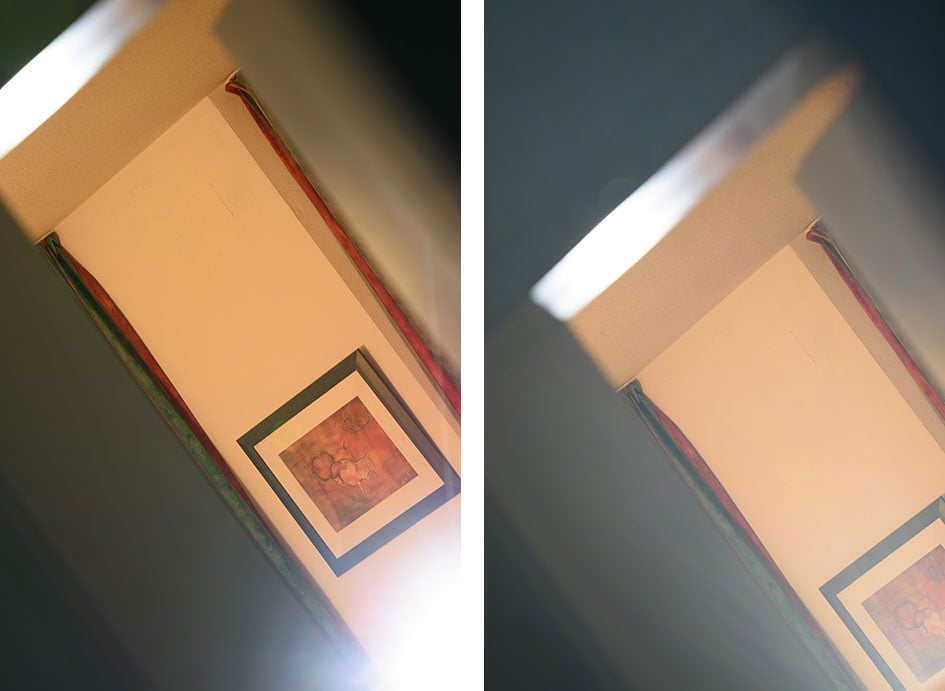
Above: Flare and ghosting. Strong light hitting the Nikon 200-500/5.6E VR from the corner of the image frame at 200mm, f5.6
So you have to watch out a bit for strong light-sources directly outside the frame. But other than that the flare-resistance of this lens is good. The following image shows the amount of ghosting that you can provoke:

Above: Ghosting. A strong light source inside the image frame of the Nikon 200-500/5.6E VR at 200mm, f5.6
Considering the extreme test-conditions ghosting is pretty moderate.
